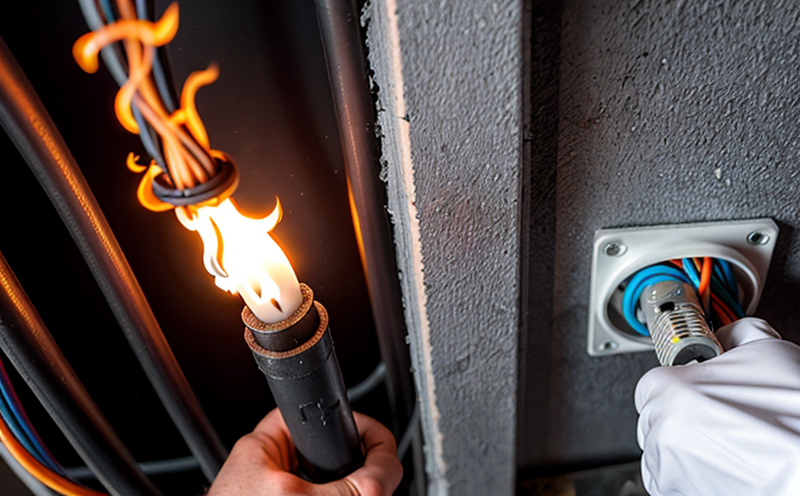IEC 60332-3-24 Test for Vertical Flame Propagation of Bunched Wires
The IEC 60332 series is an internationally recognized standard that specifies tests to determine the flame propagation characteristics of electrically insulated cables. The sub-clause IEC 60332-3-24 focuses specifically on the vertical flame propagation test for bunched wires, which is a critical aspect of ensuring fire safety in electrical installations.
This standard ensures that the materials used in wiring and cabling meet stringent fire resistance requirements. By conducting this test, manufacturers can demonstrate compliance with global safety standards, thereby enhancing consumer trust and protecting public safety. The test evaluates how rapidly flames spread along bundled wires under controlled conditions, providing essential data for product certification.
The testing procedure involves placing a sample of bunched wires into a vertical flame chamber where they are exposed to a precisely controlled flame source. The height at which the flame self-extinguishes or is extinguished by the operator defines whether the material passes or fails the test according to the specified criteria. This rigorous process ensures that only materials capable of maintaining safety standards pass this stringent evaluation.
For quality managers and compliance officers, understanding these tests is crucial for ensuring product integrity and regulatory adherence. R&D engineers benefit from detailed knowledge about flame behavior on bundled wires, which informs innovation in fire-resistant materials. Procurement teams can leverage test results to source reliable suppliers who meet international standards.
Why Choose This Test
The IEC 60332-3-24 flame propagation test is essential for several reasons. Firstly, it provides a standardized method to assess the fire resistance of bunched wires used in various electrical applications such as building wiring and industrial installations.
- Enhanced Safety: By ensuring that bundled wires do not easily catch fire or spread flames, this test contributes significantly to fire safety. This is particularly important in areas where electrical fires could have severe consequences, like residential buildings and commercial facilities.
- Compliance with Standards: Many countries and regions require compliance with IEC standards for electrical products. Conducting the IEC 60332-3-24 test ensures that your product meets these regulatory requirements, reducing the risk of legal issues or recalls.
- Quality Assurance: The test provides a reliable way to assess the quality and durability of bundled wires under fire conditions. This helps manufacturers maintain consistent product quality and customer satisfaction.
The results of this test not only provide valuable data for compliance but also serve as an indicator of product reliability and safety, which is crucial in today's competitive market environment.
Environmental and Sustainability Contributions
The IEC 60332-3-24 test contributes positively to environmental sustainability by promoting the use of fire-resistant materials that prevent electrical fires. These fires, if uncontrolled, can lead to significant damage to property and loss of life.
- Reduction in Fire Risk: By ensuring that bundled wires are flame-retardant, this test helps reduce the risk of fires starting from electrical sources. This is particularly beneficial for large buildings like hospitals, schools, and office complexes where a fire could have far-reaching impacts.
- Eco-Friendly Practices: Flame-resistant materials often require less maintenance and replacement over their lifecycle, reducing waste and resource consumption. Additionally, the use of such materials can prevent fires that might otherwise damage natural environments or infrastructure.
The adoption of these standards aligns with broader sustainability goals by promoting safer, more durable products that contribute to a healthier planet.
Use Cases and Application Examples
| Application Example | Description of Use Case |
|---|---|
| Hospitals | In hospitals, where electrical fires could disrupt critical operations or endanger lives, ensuring that bundled wires meet fire resistance standards is paramount. |
| Offices and Commercial Buildings | In commercial settings, preventing fires from spreading in electrical installations ensures business continuity and protects valuable assets. |
| Industrial Plants | For industrial plants with complex wiring systems, flame-resistant bundled wires can prevent catastrophic failures that could lead to significant downtime or accidents. |
| Railway Systems | In railway applications, ensuring the integrity of electrical cabling during emergencies is crucial for maintaining safety and preventing fires from spreading rapidly. |
These examples illustrate how the IEC 60332-3-24 test plays a vital role in various sectors where fire resistance is critical. By adhering to this standard, organizations can enhance their operational safety and comply with international regulations.





